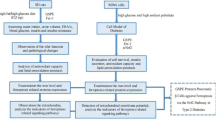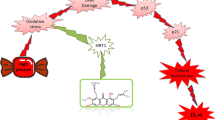Abstract
Proanthocyanidins are phenolic compounds abundant in the diet, commonly found in grapes and derivatives, foods known for their health-promoting benefits. There is previous evidence showing the antidiabetic activity of proanthocyanidins, however, their mechanisms of action have not been fully elucidated. This study evaluated the capacity of grape seed proanthocyanidins extract (GSPE) to modulate oxidative stress, nitric oxide levels, mitochondrial dysfunction, apoptosis, and sirtuin expression in endothelial cells EA.hy926 under high glucose condition. In addition, the possible toxic effects of GSPE was evaluated in a zebrafish embryos model. The results showed that GSPE was able to enhance cell viability and avoid the disturbance in redox metabolism induced by high glucose. Moreover, GSPE was able to avoid mitochondria dysfunction and the increased in p53 and poly-(ADP-ribose) polymerase expression induced by high glucose exposition. These effects were attributed to the increase in expression of sirtuin 3, a protein able to regulate mitochondrial function. GSPE in an effective concentration did not show toxic effects in zebrafish embryos model. Taken together, these data elucidate the key molecular target of GSPE for future pharmacological interventions in diabetic patients.
Graphic abstract







Similar content being viewed by others
References
Carrizzo A, Izzo C, Oliveti M, Alfano A, Virtuoso N, Capunzo M et al (2018) The main determinants of diabetes mellitus vascular complications: endothelial dysfunction and platelet hyperaggregation. Int J Mol Sci 19(10):2968. https://doi.org/10.3390/ijms19102968
Liu G, Cao M, Xu Y, Li Y (2015) SIRT3 protects endothelial cells from high glucose-induced cytotoxicity. Int J Clin Exp Pathol 8(1):353–360
Cahill PA, Redmond EM (2016) Vascular endothelium: gatekeeper of vessel health. Atherosclerosis 248:97–109. https://doi.org/10.1016/j.atherosclerosis.2016.03.007
Luo X, Wu J, Jing S, Yan LJ (2016) Hyperglycemic stress and carbon stress in diabetic glucotoxicity. Aging Dis 7(1):90–110. https://doi.org/10.14336/AD.2015.0702
Sies H (2015) Oxidative stress: a concept in redox biology and medicine. Redox Biol 4:180–183. https://doi.org/10.1016/j.redox.2015.01.002
Cai X, Bao L, Ren J, Li Y, Zhang Z (2016) Grape seed procyanidin B2 protects podocytes from high glucose-induced mitochondrial dysfunction and apoptosis via the AMPK-SIRT1-PGC-1α axis in vitro. Food Funct 7(2):805–815. https://doi.org/10.1039/c5fo01062d
Dang W (2013) The controversial world of sirtuins. Drug Discov Today Technol 12:1–17. https://doi.org/10.1038/mp.2011.182
Verdin E, Hirschey MD, Finley LWS, Haigis MC (2010) Sirtuin regulation of mitochondria: energy production, apoptosis, and signaling. Trends Biochem Sci 35(12):669–675. https://doi.org/10.1016/j.tibs.2010.07.003
Finley LWS, Carracedo A, Lee J, Souza A, Egia A, Zhang J et al (2011) SIRT3 opposes reprogramming of cancer cell metabolism through HIF1α destabilization. Cancer Cell 19(3):416–428
Bosch-Presegué L, Vaquero A (2015) Sirtuin-dependent epigenetic regulation in the maintenance of genome integrity. FEBS J 282(9):1745–1767. https://doi.org/10.1111/febs.13053
Merksamer PI, Liu Y, He W, Hirschey MD, Chen D, Verdin E (2013) The sirtuins, oxidative stress and aging: an emerging link. Aging 5(3):144–150. https://doi.org/10.18632/aging.100544
Del Rio D, Rodriguez-Mateos A, Spencer JPE, Tognolini M, Borges G, Crozier A (2013) Dietary (poly)phenolics in human health: structures, bioavailability, and evidence of protective effects against chronic diseases. Antioxid Redox Signal 18(14):1818–1892. https://doi.org/10.1089/ars.2012.4581
Gonzalez-Abuin N, Pinent M, Casanova-Marti A, Arola L, Blay M, Ardevol A (2015) Procyanidins and their healthy protective effects against type 2 diabetes. Curr Med Chem 22(1):39–50
Zhou Y, Li B-Y, Li X-L, Wang Y-J, Zhang Z, Pei F et al (2016) Restoration of mimecan expression by grape seed procyanidin B2 through regulation of nuclear factor-kappaB in mice with diabetic nephropathy. Iran J Kidney Dis 10(5):325–331
Mansouri E, Khorsandi L, Abdollahzad Fard A (2015) Protective role of grape seed proanthocyanidin antioxidant properties on heart of streptozotocin-induced diabetic rats. Vet Res Forum 6(2):119–124
Kim J, Kim K, Choi H, Park S, Stebbins CL (2018) Grape seed extract supplementation attenuates the blood pressure response to exercise in prehypertensive men. J Med Food 21(5):1–9. https://doi.org/10.1089/jmf.2017.0133
Argani H, Ghorbanihaghjo A, Vatankhahan H, Rashtchizadeh N, Raeisi S, Ilghami H (2016) The effect of red grape seed extract on serum paraoxonase activity in patients with mild to moderate hyperlipidemia. Sao Paulo Med J 134(3):234–239. https://doi.org/10.1590/1516-3180.2015.01702312
Chen F, Wang H, Zhao J, Yan J, Meng H, Zhan H et al (2019) Grape seed proanthocyanidin inhibits monocrotaline-induced pulmonary arterial hypertension via attenuating inflammation: in vivo and in vitro studies. J Nutr Biochem 67:72–77. https://doi.org/10.1016/j.jnutbio.2019.01.013
Lu J, Jiang H, Liu B, Baiyun R, Li S, Lv Y et al (2018) Grape seed procyanidin extract protects against Pb-induced lung toxicity by activating the AMPK/Nrf2/p62 signaling axis. Food Chem Toxicol 116:59–69. https://doi.org/10.1016/j.fct.2018.03.034
Rauf A, Imran M, Abu-Izneid T, Iahtisham-Ul-Haq T, Patel S, Pan X, Rasul Suleria HA (2019) Proanthocyanidins: a comprehensive review. Biomed Pharmacother. https://doi.org/10.1016/j.biopha.2019.108999
Zhao H, Ma T, Fan B, Yang L, Han C, Lou J, Kong L (2016) Protective effect of trans-d-viniferin against high glucose-induced oxidative stress in human umbilical vein endothelial cells through the SIRT1 pathway. Free Radical Res 50(1):68–83. https://doi.org/10.1515/znc-2015-0141
Spinazzi M, Casarin A, Pertegato V, Salviati L, Angelini C (2012) Assessment of mitochondrial respiratory chain enzymatic activities on tissues and cultured cells. Nat Protoc 7(6):1235–1246. https://doi.org/10.1038/nprot.2012.058
Bradford MM (1976) A dye binding assay for protein. Anal Biochem 72:248–254
Denizot F, Lang R (1986) Rapid colorimetric assay for cell growth and survival. Modifications to the tetrazolium dye procedure giving improved sensitivity and reliability. J Immunol Methods 89(2):271–277
Levine RL, Garland D, Oliver CN, Amici A, Climent I, Lenz AG, Ahn BW, Shaltiel S, Stadtman ER (1979) Determination of carbonyl content in oxidatively modified proteins. Methods Enzymol 186:464–478. https://doi.org/10.1016/0049-0172(79)90003-9
Bannister JV, Calabrese L (1987) Assays for superoxide dismutase. Methods Biochem Anal 32:279–312. https://doi.org/10.1002/9780470110539.ch5
Aebi H (1984) Catalase in vitro. Methods Enzymol 105:121–126
Green LC, Wagner DA, Glogowski J, Skipper PL, Wishnok JS, Tannenbaum SR (1982) Analysis of nitrate, nitrite, and [15N] nitrate in biological fluids automated NO; and NO? Analysis 126(1):131–138. https://doi.org/10.1016/0003-2697(82)90118-X
dos Branco CS, de Lima ÉD, Rodrigues TS, Scheffel TB, Scola G, Laurino CCFC, Salvador M (2015) Mitochondria and redox homoeostasis as chemotherapeutic targets of Araucaria angustifolia (Bert.) O. Kuntze in human larynx HEp-2 cancer cells. Chemico-Biol Interact 231:108–118
OECD (2013). Education at a glance 2013. DOI:10.1787/gov_glance-2011-en
Kimmel CB, Ballard WW, Kimmel SR, Ullmann B, Schilling TF (1995) ZFIN embyonic developmental stages. Dev Dyn 10:253–310
Poulsen RC, Knowles HJ, Carr AJ, Hulley PA (2014) Cell differentiation versus cell death: extracellular glucose is a key determinant of cell fate following oxidative stress exposure. Cell Death Dis 5(2):e1074–e1112. https://doi.org/10.1038/cddis.2014.52
Gao J, Zheng Z, Gu Q, Chen X, Liu X, Xu X (2016) Deacetylation of MnSOD by PARP-regulated SIRT3 protects retinal capillary endothelial cells from hyperglycemia-induced damage. Biochem Biophys Res Commun 472(3):425–431. https://doi.org/10.1016/j.bbrc.2015.12.037
Vogelstein B, Lane D, Levine AJ (2000) Surfing the p53 network. Nature 408(6810):307–310. https://doi.org/10.1038/35042675
Shen H, Zhao J, Liu Y, Sun G (2018) Interactions between and shared molecular mechanisms of diabetic peripheral neuropathy and obstructive sleep apnea in type 2 diabetes patients. J Diab Res 2018:1–15. https://doi.org/10.1155/2018/3458615
Kang H, Ma X, Liu J, Fan Y, Deng X (2017) High glucose-induced endothelial progenitor cell dysfunction. Diab Vasc Dis Res 14(5):381–394. https://doi.org/10.1177/1479164117719058
Sivitz WI, Yorek MA (2010) Mitochondrial dysfunction in diabetes: from molecular mechanisms to functional significance and therapeutic opportunities. Antioxid Redox Signal. https://doi.org/10.1089/ars.2009.2531
Qian Y, Babu PVA, Symons JD, Jalili T (2017) Metabolites of flavonoid compounds preserve indices of endothelial cell nitric oxide bioavailability under glucotoxic conditions. Nutr Diab 7(9):e286. https://doi.org/10.1038/nutd.2017.34
Wu J, Luo X, Thangthaeng N, Sumien N, Chen Z, Rutledge MA et al (2017) Pancreatic mitochondrial complex I exhibits aberrant hyperactivity in diabetes. Biochem Biophys Rep 11:119–129. https://doi.org/10.1016/j.bbrep.2017.07.007
Silva Santos LF, Stolfo A, Calloni C, Salvador M (2017) Catechin and epicatechin reduce mitochondrial dysfunction and oxidative stress induced by amiodarone in human lung fibroblasts. J Arrhythmia 33(3):220–225. https://doi.org/10.1016/j.joa.2016.09.004
Ramirez-Sanchez I, Mansour C, Navarrete-Yañez V, Ayala-Hernandez M, Guevara G, Castillo C et al (2018) (−)-Epicatechin induced reversal of endothelial cell aging and improved vascular function: underlying mechanisms. Food Funct 9(9):4802–4813. https://doi.org/10.1039/c8fo00483h
Janssen RJRJ, Nijtmans LG, van den Heuvel LP, Smeitink JAM (2006) Mitochondrial complex I: structure, function and pathology. J Inherit Metab Dis 29(4):499–515. https://doi.org/10.1007/s10545-006-0362-4
Andreazza AC, Shao L, Wang JF, Young LT (2010) Mitochondrial complex I activity and oxidative damage to mitochondrial proteins in the prefrontal cortex of patients with bipolar disorder [Erratum appears in Arch Gen Psychiatry. 2010 Dec;67(12):1254]. Arch Gen Psychiatry 67(4):360–368
Nogueiras R, Habegger KM, Chaudhary N, Finan B, Banks AS, Dietrich MO, Horvath TL, Sinclair DA, Pfluger PT, Tschöp MH (2012) Sirtuin 1 and sirtuin 3: physiological modulators of metabolism. Physiol Rev 92(3):1479–1514. https://doi.org/10.1016/j.bmcl.2009.08.098
Yoon Y, Galloway CA, Jhun BS, Yu T (2011) Mitochondrial dynamics in diabetes. Antioxid Redox Signal 14(3):439–457. https://doi.org/10.1089/ars.2010.3286
Goutzourelas N, Stagos D, Housmekeridou A, Karapouliou C, Kerasioti E, Aligiannis N et al (2015) Grape pomace extract exerts antioxidant effects through an increase in GCS levels and GST activity in muscle and endothelial cells. Int J Mol Med 36(2):433–441. https://doi.org/10.3892/ijmm.2015.2246
Goutzourelas N, Stagos D, Spanidis Y, Liosi M, Apostolou A, Priftis A et al (2015) Polyphenolic composition of grape stem extracts affects antioxidant activity in endothelial and muscle cells. Mol Med Rep 12(4):5846–5856. https://doi.org/10.3892/mmr.2015.4216
Fusi J, Bianchi S, Daniele S, Pellegrini S, Martini C, Galetta F et al (2018) An in vitro comparative study of the antioxidant activity and SIRT1 modulation of natural compounds. Biomed Pharmacother 101:805–819. https://doi.org/10.1016/j.biopha.2018.03.006
Li Y, Wu S (2018) Epigallocatechin gallate suppresses hepatic cholesterol synthesis by targeting SREBP-2 through SIRT1/FOXO1 signaling pathway. Mol Cell Biochem 448(1–2):175–185. https://doi.org/10.1007/s11010-018-3324-x
Song JH, Lee HJ, Kang KS (2019) Procyanidin C1 activates the Nrf2/HO-1 signaling pathway to prevent glutamate-induced apoptotic HT22 cell death. Int J Mol Sci. https://doi.org/10.3390/ijms20010142
Han H, Wang H, Du Y, Gao L (2019) Grape seed procyanidins attenuates cisplatin-induced human embryonic renal cell cytotoxicity by modulating heme oxygenase-1 in vitro. Cell Biochem Biophys. https://doi.org/10.1007/s12013-019-00890-5
Pamanji R, Yashwanth B, Bethu MS, Leelavathi S, Ravinder K, Venkateswara Rao J (2015) Toxicity effects of profenofos on embryonic and larval development of Zebrafish (Danio rerio). Environ Toxicol Pharmacol 39(2):887–897. https://doi.org/10.1016/j.etap.2015.02.020
Sarasquete C, Úbeda-manzanaro M, Ortiz-delgado JB (2018) Toxicity and non-harmful effects of the soya isoflavones, genistein and daidzein, in embryos of the zebrafish, Danio rerio. Comp Biochem Physiol C 211:57–67. https://doi.org/10.1016/j.cbpc.2018.05.012
Wiegand C, Pflugmacher S, Giese M, Frank H, Steinberg C (2000) Uptake, toxicity, and effects on detoxication enzymes of atrazine and trifluoroacetate in embryos of zebrafish. Ecotoxicol Environ Saf 45(2):122–131. https://doi.org/10.1006/eesa.1999.1845
Vallverdú-queralt A, Boix N, Piqué E, Gómez-catalan J, Lamuela-raventos RM (2015) Identification of phenolic compounds in red wine extract samples and zebrafish embryos by HPLC-ESI-LTQ-Orbitrap-MS. Food Chem 181:146–151. https://doi.org/10.1016/j.foodchem.2015.02.098
Li K, Liu C, Tam JC, Kwok H, Lau C, Leung P et al (2014) In vitro and in vivo mechanistic study of a novel proanthocyanidin, GC-(4→8)-GCG from cocoa tea (Camellia ptilophylla) in antiangiogenesis. J Nutr Biochem 25(3):319–328. https://doi.org/10.1016/j.jnutbio.2013.11.006
Lee IS, Yu SY, Jung SH, Lee YR, Lee YM, Kim JH, Sun H, Kim JS (2013) Proanthocyanidins from Spenceria ramalana and their effects on zebrafish in vivo AGE formation in vitro and hyaloid-retinal vessel dilation in larval. J Nat Prod 76(10):1881–1888
Acknowledgements
This work was supported by the Conselho Nacional de Desenvolvimento Científico e Tecnológico (CNPq), Fundação de Amparo à Pesquisa do Estado do Rio Grande do Sul (FAPERGS), and the Coordenação de Apoio de Pessoal de Nível Superior (CAPES). A.F.C. is the recipient of a CAPES Research Fellowship and M.S. is the recipient of a CNPq Research Fellowship (3033383/2015-1). Special thanks to L.A.B for technical contribution and M.A.O.S. for all the support.
Author information
Authors and Affiliations
Corresponding author
Ethics declarations
Conflict of interest
The authors declare no conflict of interest.
Ethical approval
All applicable international, national, and/or institutional guidelines for the care and use of animals were followed.
Additional information
Publisher's Note
Springer Nature remains neutral with regard to jurisdictional claims in published maps and institutional affiliations.
Rights and permissions
About this article
Cite this article
Cerbaro, A.F., Rodrigues, V.S.B., Rigotti, M. et al. Grape seed proanthocyanidins improves mitochondrial function and reduces oxidative stress through an increase in sirtuin 3 expression in EA.hy926 cells in high glucose condition. Mol Biol Rep 47, 3319–3330 (2020). https://doi.org/10.1007/s11033-020-05401-x
Received:
Accepted:
Published:
Issue Date:
DOI: https://doi.org/10.1007/s11033-020-05401-x




